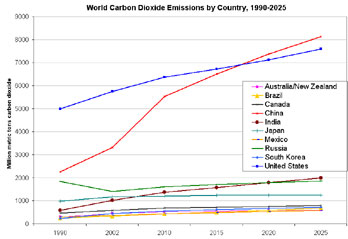ConocoPhillips becomes first U.S. oil major to call for CO2 limits
ConocoPhillips becomes first U.S. oil major to call for CO2 limits
Rhett A. Butler, mongabay.com
April 11, 2007
This week ConocoPhillips became the first major U.S. oil firm to call for a legally-binding emissions cap. The Houston-based company said it would join the U.S. Climate Action Partnership (USCAP), a coalition of corporations seeking to influence future climate policy.
“We recognize that human activity, including the burning of fossil fuels, is contributing to increased concentrations of greenhouse gases in the atmosphere that can lead to adverse changes in global climate,” said Jim Mulva, chairman and chief executive officer. “While we believe no one entity can alone address the environmental, economic and technological issues inherent in any solution, ConocoPhillips will show leadership in finding pragmatic and sustainable solutions.”
“In addition to taking actions in our own businesses, we believe it is important that business should step forward to help devise practical, equitable and cost-effective approaches to address the concentration of greenhouse gases in the atmosphere at both a national and international level. To that end, we have joined USCAP in support of the development of a mandatory national regulatory framework to reduce the level of greenhouse gas emissions. Further, we believe that a mandatory national framework that links to international programs is most likely to achieve meaningful impact on global greenhouse gas emissions.”

|
“Any such framework should be transparent, clearly communicate the cost of carbon to consumers, be structured to avoid increasing the volatility of energy prices, and encourage energy efficiency. It also should be paced to match the speed at which technology can be developed and deployed, in order to avoid undue impact on the economy including any impact on the number and location of jobs. The most likely and prudent approach will result in a slow, stop, reverse pattern.”
ConocoPhillips joins European-based BP as the only oil firms in USCAP. Its announcement comes a week after the U.S. Supreme Court ruled that the Environmental Protection Agency (EPA) must regulate carbon dioxide emissions from cars. The decision opens the door for a legal framework on greenhouse gas emissions.
The U.S. transportation sector produced about 6 percent of global carbon emissions and around a third of total U.S. energy-related carbon-dioxide emissions in 2005, according to the Department of Energy’s Energy Information Administration (EIA). EIA figures show that in 2005 total U.S. greenhouse gas emissions rose to 7,147 million metric tons, a new record. About 83 percent of total U.S. greenhouse gas emissions in 2005 consisted of carbon dioxide from the use of fossil fuels including coal, petroleum, and natural gas.
 CO2 emissions by country, click to enlarge |
The U.S. is the largest producer of carbon dioxide. China, the number two emitter, is expected to surpass the United States this year or next, though its emissions per capita will still less than a quarter of that of the U.S.
Overall, atmospheric CO2 levels have climbed by more than 35 percent since the beginning of the industrial revolution. Fossil fuel combustion, which releases carbon dioxide into the atmosphere, and land-use change, including deforestation, is blamed for the rise. Roughly 75-80 percent of anthropogenic carbon dioxide results from fossil fuel burning, while about 20-25 percent is produced by deforestation. The United States, the world’s largest economy and consumer of energy, produces about 24% of global carbon dioxide emissions.
Scientists believe rising levels of carbon dioxide and other greenhouse gases are causing Earth’s atmosphere to warm. Research released last year by NASA, WMO, and the National Academy of Sciences found that 2005 was the warmest year in at least the 400 years, and possibly much longer. The WMO said that carbon dioxide has accounted for 90 percent of warming over the past decade.
The Intergovernmental Panel on Climate Change (IPCC) projects that atmospheric carbon dioxide levels could rise to 450-550 ppm by 2050, possibly resulting in higher temperatures, rising sea levels, stronger storms and hurricanes, and expanding deserts.